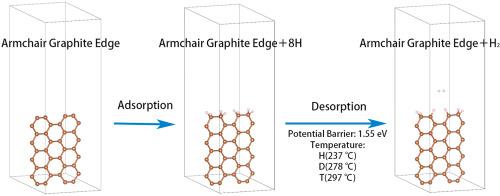Our official English website, www.x-mol.net, welcomes your
feedback! (Note: you will need to create a separate account there.)
Tritium adsorption and desorption on/from nuclear graphite edge by a first-principles study
Carbon ( IF 10.5 ) Pub Date : 2021-03-01 , DOI: 10.1016/j.carbon.2020.11.014 Mingjun Zhang , Xijun Wu , Guo Yang , Nan Qian , Fei Wei , Chao Zhao , Jiayu Liu , Ke Deng , Wei Liu
Carbon ( IF 10.5 ) Pub Date : 2021-03-01 , DOI: 10.1016/j.carbon.2020.11.014 Mingjun Zhang , Xijun Wu , Guo Yang , Nan Qian , Fei Wei , Chao Zhao , Jiayu Liu , Ke Deng , Wei Liu

|
Abstract The removal of tritium from irradiated nuclear graphite is one of the key targets of nuclear graphite decontamination. Here, we employ first principle density functional theory (DFT) to study its adsorption and molecular desorption on the most common edges and their reconstructions. The calculated adsorption energy ranges from −2.6 to - 5 eV, depending on the edge structure and the hydrogenation level, and are much larger than on the bulk of graphite. The hydrogenation level increases with the increase of hydrogen partial pressure, and drops rapidly at high temperature. The pathways to fully saturated edges are then determined for each edge variant and the activation energy (Eac) for molecular desorption computed by properly accounting for vibrational zero-point energy corrections (ΔEZPE). Our results showed that, there are three different stages for the desorption of hydrogen isotopes from nuclear graphite, namely stage 1 (200–300 °C), stage 2 (500–700 °C), stage 3 (1000–1100 °C). Our results can provide a theoretical basis for the tritium removal experiment from nuclear graphite.
中文翻译:

第一性原理研究氚在核石墨边缘上的吸附和解吸
摘要 辐照核石墨中氚的去除是核石墨去污的关键目标之一。在这里,我们采用第一原理密度泛函理论 (DFT) 来研究其在最常见边缘上的吸附和分子解吸及其重建。计算出的吸附能范围为 -2.6 到 - 5 eV,具体取决于边缘结构和氢化水平,并且比大块石墨大得多。加氢水平随氢分压的增加而增加,在高温下迅速下降。然后确定每个边缘变体的完全饱和边缘的路径,并通过适当考虑振动零点能量校正 (ΔEZPE) 计算分子解吸的活化能 (Eac)。我们的结果表明,从核石墨中解吸氢同位素有三个不同的阶段,即阶段 1(200-300°C)、阶段 2(500-700°C)、阶段 3(1000-1100°C)。我们的研究结果可为核石墨中的氚去除实验提供理论依据。
更新日期:2021-03-01
中文翻译:

第一性原理研究氚在核石墨边缘上的吸附和解吸
摘要 辐照核石墨中氚的去除是核石墨去污的关键目标之一。在这里,我们采用第一原理密度泛函理论 (DFT) 来研究其在最常见边缘上的吸附和分子解吸及其重建。计算出的吸附能范围为 -2.6 到 - 5 eV,具体取决于边缘结构和氢化水平,并且比大块石墨大得多。加氢水平随氢分压的增加而增加,在高温下迅速下降。然后确定每个边缘变体的完全饱和边缘的路径,并通过适当考虑振动零点能量校正 (ΔEZPE) 计算分子解吸的活化能 (Eac)。我们的结果表明,从核石墨中解吸氢同位素有三个不同的阶段,即阶段 1(200-300°C)、阶段 2(500-700°C)、阶段 3(1000-1100°C)。我们的研究结果可为核石墨中的氚去除实验提供理论依据。











































 京公网安备 11010802027423号
京公网安备 11010802027423号